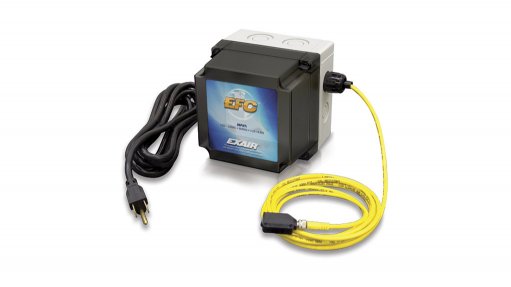
ELECTRONIC FLOW CONTROL The EFC device turns the air product on and off only when required
Leak detection in a compressed-air system can lead to significant energy savings, as compressors will have to work less frequently to replenish lost air, says KwaZulu-Natal-based industrial instrumentation and control equipment supplier Etest.
Etest is the local distributor of US-based compressed-air products manufacturer Exair and distributes products such as ultrasonic leak detectors (ULD), flow control devices and receiver tanks, among other products.
Leaks in compressed-air systems can be common, as they can occur because of the mechanical motion of the piping system, poor plumbing practices, incorrect joint tightening or impact on the pipe system.
The company notes that using leak detection equipment enables air users to detect minor and major leaks. Minor leaks are difficult to detect, as they are often inaudible to the unaided human ear, owing to the high-frequency sound produced by air leaking from a small orifice.
Corrosion, which usually occurs over time, further adds to weak spots in the compressed-air system.
Etest spokesperson Terri Carlson says the Exair model 9061 ULD – a hand-held device that is equipped with a microphone – provides audio and visual indications of leaks. The device can detect ultrasonic noise signatures through its band pass filters. These filters enable the microphone to detect ultrasonic frequencies from 20 kHz to 100 kHz. In addition, the ULD has an ultrasensitive detection zone in the 35 kHz to 45 kHz range.
In addition, headphones connected to the device enable the ULD operator to listen when the ULD detects a leak. Further enhancement of detecting leaks can be achieved through the supplied parabola attachment, which enables the operator to focus on specific areas by pinpointing the ULD at the exact location of the leak.
“The user points the microphone towards joints in the compressed-air piping and other items connected to the network. When the ULD detects an ultrasonic noise signature, it will register a white noise through the headphones and also provides a visual indication by lighting up several light-emitting diodes in progressive succession as the sound level becomes more intense,” she says.
Once the ULD operator is certain of the location of the noise, the area is marked and can subsequently be repaired.
Airflow Control
An electronic flow-control (EFC) device can further add to substantial air and energy savings when incorporated into key aspects of a compressed-air system such as areas where air is required only for intermittent periods.
The device is a standalone sensor and solenoid valve unit to which any of Etest’s air-operated products can be fitted.
“The EFC can save an unlimited amount of air, depending on how much air is being controlled by the unit,” says Carlson, adding that other factors, such as the amount of time during which the EFC device is switched on or off, can affect the exact amount of air that can be conserved. “We have cited air savings of as much as 85%,” she continues.
The EFC device turns the air product on and off only when required, reducing air wasted on the product when the device is not in use.
“The optical sensor of the device has an adjustable sensitivity, with a range of up to 1 m. It operates when the target crosses the path of the EFC, after which the unit activates the solenoid valve in one of eight custom modes,” says Carlson, adding that timing adjustments are infinite.
Further, an air-receiver tank supplied by the company also enables intermittent use of large quantities of air for a short period to save money, as the compressor will be required to replenish air supply only once the receiver tank reaches a certain threshold of air. “Instead of relying on the piping network of a facility for compressed-air storage, the receiver tank makes the supply of compressed air immediately available, without any drop in pressure in the air network while air tools are being used,” she concludes.